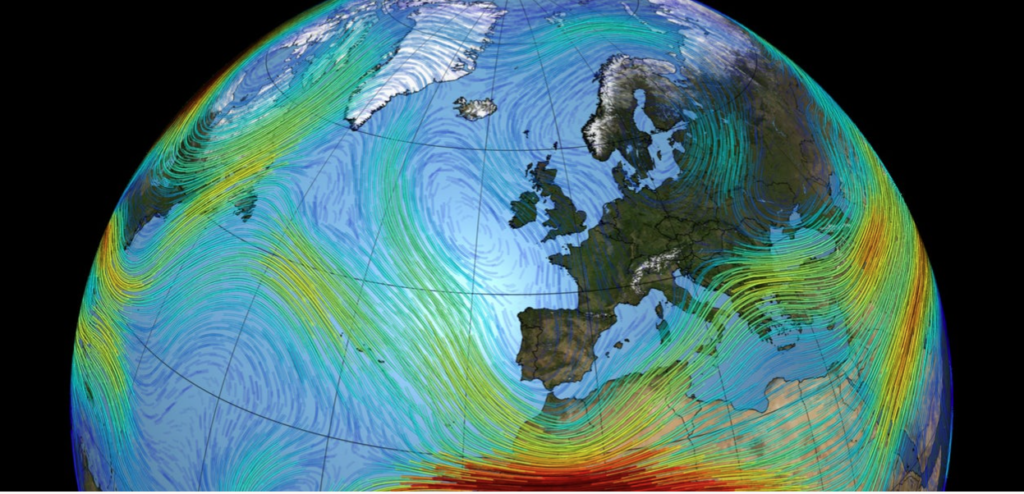SUMMER WIND PATTERNS IN THE NORTH ARE CHANGING DUE TO CLIMATE CHANGE
The paper is led by Rei Chemke (Department of Earth and Planetary Sciences, Weizmann Institute of Science) and Dim Coumou (Institute for Environmental Studies, VU Amsterdam).
Reference: Chemke R. and Coumou D.: “Human influence on the recent weakening of storm tracks in boreal summer« , npj Clim Atmos Sci, 7, 86 (2024), https://doi.org/10.1038/s41612-024-00640-2
The emissions of greenhouse gases and aerosols have led to a weakening of weather systems in the summer on the Northern Hemisphere. This is revealed by climate scientists at the Weizmann Institute and the Institute for Environmental Studies (IVM) of VU Amsterdam. They investigated how weather systems changed in the atmosphere as a result of climate change. The weakening is likely bad news for the occurrence of drought and heatwaves.
Hotter and drier summers
In recent years, there have been intense summer droughts and heatwaves in regions such as Europe and the United States. In Europe, heatwaves are increasing faster than elsewhere, and the soils have steadily dried since the 1980s. This trend toward hot and dry extremes in the summer poses serious risks to society, including wildfires, crop failures, and health risks. It is clear that a warming planet leads to warmer summers and more evaporation, which amplifies such hot and dry extremes. However, this cannot fully explain the rapid upward trend; changes in large-scale wind patterns also play a role.
Caused by human emissions
« In the mid-latitudes, the atmospheric flow is characterized by high-pressure and low-pressure weather systems that flow from west to east, » explains Rei Chemke, senior scientist at the Weizmann Institute and lead author of the study published in npj Climate and Atmospheric Science. « The intensity of these weather systems, or as we call them, ‘storm tracks’, has been decreasing since 1980, » he adds. We have shown for the first time that this weakening is due to anthropogenic emissions of greenhouse gases, such as CO2, and aerosols. To do this, the scientists analyzed massive amounts of climate data, both from observations and from advanced climate models. Only when the historical emissions are included in the calculations of the climate models, can the observed weakening be explained.
Warming of the polar region
« The underlying mechanisms of the weakening of the flow point to the high latitudes, » says Chemke. The polar region is warming faster than other regions. The temperature difference between northern and southern latitudes has therefore become smaller, and this reduction has led to a weakening of the storm tracks. « The temperature difference between high and low latitudes drives the storm tracks, and the stronger warming in the high latitudes thus leads to weakening of the atmospheric flow, » adds co-author and VU professor of Climate Extremes and Societal Risk Dim Coumou « We see these changes both in observations and in climate models, and this consistency gives us confidence in understanding why the weakening is happening, » he adds. Emissions of both greenhouse gases and aerosols – tiny particles released during the combustion of coal or other sources – seem to play a more or less equally important role in weakening the flow. Further research should uncover in more detail the role of these different types of emissions.
Need to reduce emissions
« The latest IPCC report indicates low confidence in the role of emissions on storm tracks in the Northern Hemisphere. Our study shows that human activity is already changing the storm tracks, and that is really a major concern, » concludes Chemke. « In summer, low-pressure systems bring relatively moist, cool, and cloudy conditions from the oceans to continents. A weakening of the flow means that such cool maritime air masses occur less frequently, creating favorable conditions for the buildup of heat and drought over continents. » The study is the latest in a growing number of publications showing that atmospheric flow patterns are already changing due to climate change. This underscores the urgency to reduce emissions.

Image: NASA’s Scientific Visualization Studio
